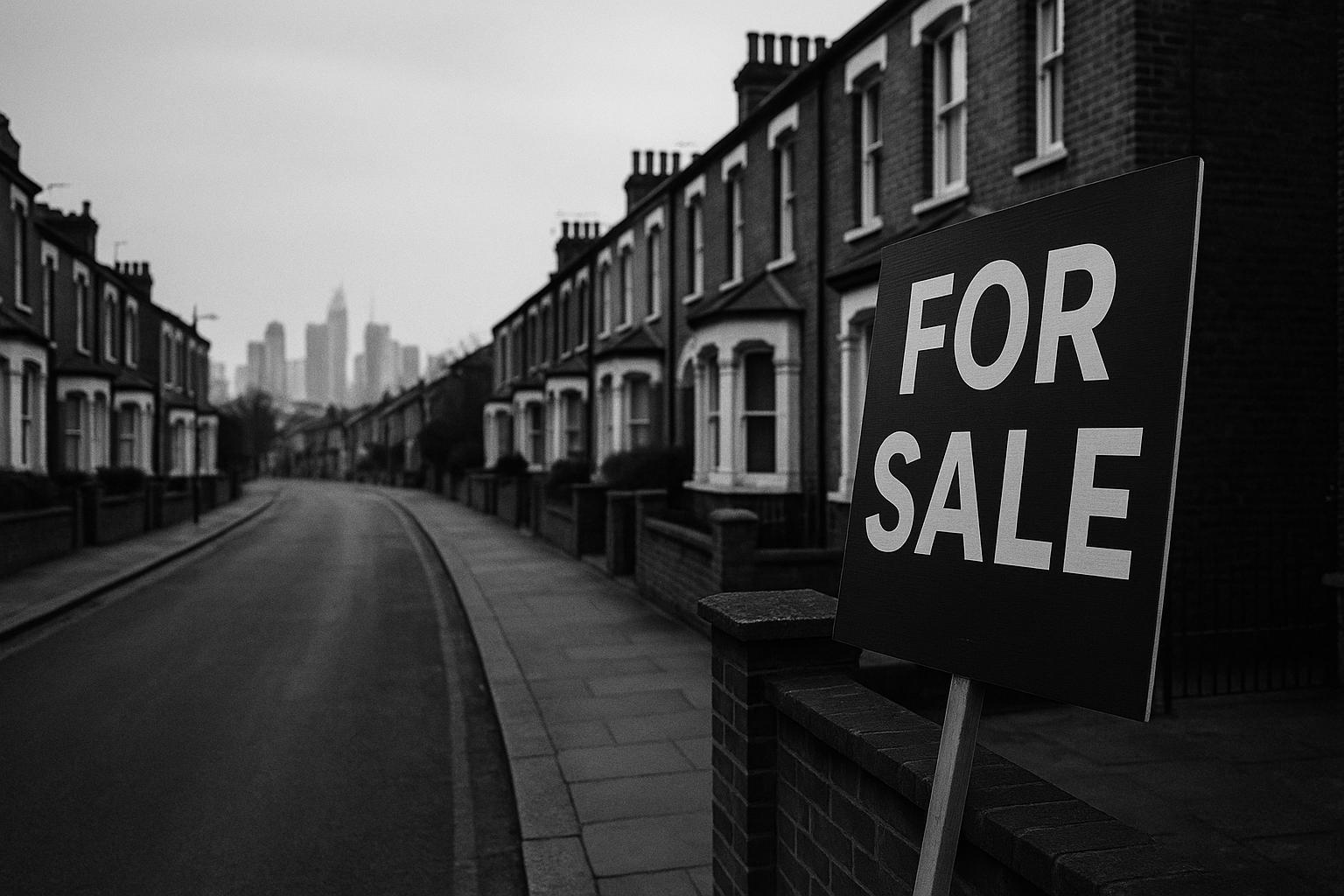Barratt Redrow reports lower-than-expected home sales amid high interest rates and a fall in international buyers, particularly in London, where demand remains fragile. While mortgage rates ease and government schemes aim to support first-time buyers, affordability challenges and economic uncertainty continue to suppress broader housing market recovery.
The UK housing market continues to navigate a complex landscape shaped by economic pressures, shifting buyer behaviour, and evolving government and regulatory interventions. Barratt Redrow, a leading homebuilder, revealed in its recent fiscal update that sales fell short of expectations, with 16,565 homes sold against a guidance range of 16,800 to 17,200 for the year ending June 2025. The company attributed this underperformance principally to high interest rates and a notable decline in international buyers, particularly in London, where demand remains weak. CEO David Thomas highlighted a significant drop in first-time buyers in the capital and indicated the business is seeking to stimulate interest through innovative products such as rent-before-you-buy schemes and shared equity options. Despite near-term challenges, Barratt Redrow remains confident in its medium-term target of building 22,000 homes annually, projecting sales of between 17,200 and 17,800 for the current fiscal year.
The wider housing market reflects a similar sentiment of caution. The London market, in particular, is described as “challenging,” with fragile demand both domestically and internationally. Consumer hesitancy is largely shaped by affordability difficulties and economic uncertainty. Recent data suggests that while some modest improvements in mortgage competition and availability are emerging, these have not yet translated into a substantial rebound in housing transactions. The Bank of England’s recent easing of mortgage lending restrictions aims to alleviate some of the pressure on prospective buyers. By allowing individual lenders to exceed the previous 15% cap on high loan-to-income mortgages, the Bank hopes to make financing accessible to more first-time buyers. However, the Bank noted that deposit requirements continue to be a more significant barrier, and high LTI lending still accounts for less than 10% of total lending, underscoring the slow pace of market adaptation.
Mortgage rates in the UK have shown encouraging signs of easing, as major lenders engage in competitive pricing to attract buyers. Average two- and five-year fixed rates have declined to just above 5%, with some deals dropping below 4% for low-risk borrowers. This downward trajectory is driven by falling swap rates and expectations of a forthcoming Bank of England base rate cut. Market watchers point to an intensifying ‘price war’ among lenders such as HSBC, Halifax, Barclays, and Nationwide, making borrowing costs more affordable for a broader segment of buyers, including first-time purchasers, remortgagers, and self-builders. However, experts caution that these attractive rates may not last indefinitely if lender funding costs rise or profit margins are squeezed, urging prospective buyers to act swiftly to lock in favourable terms.
The government is also stepping up efforts to support homebuyers with the imminent launch of a permanent mortgage guarantee scheme called ‘Freedom to Buy.’ Announced by Chancellor Rachel Reeves and set to be detailed shortly, the initiative will enable borrowers to access 95% loan-to-value mortgages with just a 5% deposit. By backing these loans, the government aims to reduce risk for lenders and encourage a more stable mortgage supply, particularly during economic downturns. While the scheme has garnered support from housing policy experts and smaller lenders for the stability it promises, some mortgage brokers remain sceptical about its effectiveness in overcoming lenders’ conservatism. The plan caps government liability at £3.2 billion and requires lenders to pay fees to offset potential losses, aiming to balance support with fiscal responsibility.
House price trends in 2025 have been influenced by a mix of factors including stamp duty holiday changes, regional supply variations, and fluctuating buyer activity. After a surge early in the year due to tax incentives, prices dipped slightly in June, with figures from Nationwide showing a 0.8% fall and Halifax reporting no growth. Nevertheless, annual house price growth remains modestly positive between 2% and 2.5%, supported by strong employment levels and rising incomes. Regional disparities are increasingly pronounced: London and southern England experience subdued growth and an oversupply of housing, while northern and rural markets, buoyed by lower prices and limited inventory, show more robust appreciation. Northern Ireland stands out with a notable 9.5% annual increase. Market analysts remain cautiously optimistic, forecasting moderate home price increases through the year, reflecting a market in gradual recovery but still tempered by affordability challenges.
In summary, the UK housing market is at a critical juncture. While mortgage rates are easing and government initiatives strive to enhance access to financing, consumer caution driven by economic conditions and affordability issues continues to suppress demand, especially in London. The combination of regulatory adjustments, competitive lending, and new policy measures may gradually unlock latent demand, but the market’s recovery is likely to be uneven and dependent on broader economic stability and affordability improvements.
 Reference Map:
Reference Map:
- Paragraph 1 – [1], [2]
- Paragraph 2 – [1], [3]
- Paragraph 3 – [4], [5]
- Paragraph 4 – [6]
- Paragraph 5 – [7]
- Paragraph 6 – [1], [2], [3], [4], [5], [6], [7]
Source: Noah Wire Services
- https://www.standard.co.uk/business/business-news/london-stocks-dow-jones-industrial-average-new-york-investors-b1238332.html – Please view link – unable to able to access data
- https://www.ft.com/content/39f9abd1-ea4a-44ac-bbb3-24dfa39e8103 – Barratt Redrow, a UK housebuilder, reported lower-than-expected home sales for the fiscal year ending in June 2025. The company sold 16,565 homes, missing its April guidance of 16,800–17,200. The shortfall was attributed to high interest rates and a decline in international buyers, particularly in London. CEO David Thomas highlighted reduced first-time buyer numbers in London and revealed ongoing efforts to attract buyers through new incentives like rent-before-you-buy schemes and a shared equity product. For the 2026 fiscal year, Barratt anticipates selling 17,200–17,800 homes and maintains a medium-term goal of building 22,000 homes annually. ([ft.com](https://www.ft.com/content/39f9abd1-ea4a-44ac-bbb3-24dfa39e8103?utm_source=openai))
- https://www.reuters.com/sustainability/boards-policy-regulation/uk-banks-can-increase-riskier-mortgage-lending-boe-says-2025-07-09/ – The Bank of England (BoE) announced a relaxation in mortgage lending rules, allowing individual UK banks and building societies to issue more high loan-to-income (LTI) mortgages. While the sector-wide cap remains at 15%, individual entities may now exceed this limit, addressing the BoE’s finding that banks have been operating well below the threshold, hindering market growth. This move aims to help more first-time buyers enter the housing market, although the BoE noted that deposit requirements remain a greater obstacle. The high LTI lending cap was originally introduced in 2014 to curtail risky lending that contributed to the 2008 financial crisis. The BoE reported that in the first quarter of 2025, high LTI loans comprised 9.7% of total lending and expects this could rise to 11% by the end of the year under the new flexibility. Additionally, the BoE will review overall bank capital requirements and report its findings in its December financial stability update, although it currently views capital levels as broadly appropriate. ([reuters.com](https://www.reuters.com/sustainability/boards-policy-regulation/uk-banks-can-increase-riskier-mortgage-lending-boe-says-2025-07-09/?utm_source=openai))
- https://moneyweek.com/personal-finance/mortgages/latest-UK-mortgage-rates – Mortgage rates in the UK are currently on a downward trend, with major lenders such as HSBC, Halifax, Barclays, Nationwide, and others reducing their fixed-rate and buy-to-let mortgage deals. For instance, HSBC is making its third rate cut in two weeks, indicating aggressive competition among lenders. Average two-year fixed rates have dropped to 5.05%, the lowest since September 2022, with five-year rates at around 5.04%. Factors contributing to rate reductions include falling swap rates, the Bank of England’s decision to hold interest rates at 4.25%, and expectations of future rate cuts. Experts suggest that more reductions may come later in the year, depending on economic indicators like inflation and GDP. The Financial Conduct Authority (FCA) is also reviewing mortgage regulations to better support homebuyers. While lower mortgage rates are welcome news for borrowers, those with maturing fixed deals or variable-rate mortgages should consider switching to avoid higher costs. Over 80 mortgage products now offer rates below 4%. Borrowers are advised to compare deals carefully, considering fees and their long-term affordability, and to take action early as competition intensifies among lenders. ([moneyweek.com](https://moneyweek.com/personal-finance/mortgages/latest-UK-mortgage-rates?utm_source=openai))
- https://www.homebuilding.co.uk/news/are-mortgage-rates-going-down – In July 2025, UK mortgage rates have significantly decreased as major lenders such as Halifax, Nationwide, and Barclays initiate competitive fixed-rate offers. Two- and five-year fixed mortgages now average slightly above 5%, with certain deals dropping below 4% for low-risk borrowers. This trend is fueled by falling swap rates and market anticipation of a 0.25% base rate cut by the Bank of England on August 7, 2025. The resulting ‘price war’ among lenders is creating highly attractive conditions for buyers, remortgagers, and even first-time buyers, who are seeing rates lower than previous months. Self-builders and renovators also benefit, as lower borrowing costs improve project affordability. Standout offers include Nationwide’s 2-year fix at 3.81% for high-equity purchasers and BM Solutions’ buy-to-let remortgage at 2.78%. While further base rate cuts may be limited, acting now could help lock in the year’s most favorable rates. However, there is a possibility that some of the lowest rates could be withdrawn if funding costs increase or lender margins are squeezed. Prospective borrowers are urged to stay updated and act promptly to capitalize on this unique market window. ([homebuilding.co.uk](https://www.homebuilding.co.uk/news/are-mortgage-rates-going-down?utm_source=openai))
- https://www.ft.com/content/61ecefb1-fd95-4d74-be21-8dbd5de562e3 – Chancellor Rachel Reeves will announce the launch of a permanent mortgage guarantee scheme, named ‘Freedom to Buy,’ aimed at helping first-time homebuyers during economic downturns. The initiative, to be unveiled in her Mansion House speech on July 15, is a continuation and formalization of a temporary scheme introduced under the Conservative government in 2021 during the COVID-19 pandemic. The scheme will allow buyers to access 95% loan-to-value mortgages with just a 5% deposit, as the government backs the loans to mitigate risk for lenders. Lenders will pay fees to the Treasury to offset potential losses, with a cap on government liability set at £3.2 billion. City minister Emma Reynolds emphasized that the permanent availability of the scheme will give lenders greater consistency and confidence. While the plan has been welcomed by housing policy experts and smaller lenders, who note its potential to stabilize market offerings during downturns, some industry voices, like mortgage broker Martin Stewart, criticized it as ineffective, citing lender caution despite government backing. Reeves is also expected to propose reforms to the Individual Savings Account (ISA) system to incentivize investment in stocks and shares. ([ft.com](https://www.ft.com/content/61ecefb1-fd95-4d74-be21-8dbd5de562e3?utm_source=openai))
- https://moneyweek.com/investments/house-prices/house-prices – UK house prices have experienced fluctuations in 2025, primarily due to stamp duty changes. A surge in transactions occurred early in the year before the tax-free allowance reduction, followed by slower market activity. June saw a 0.8% price drop, according to Nationwide, and zero growth per Halifax, although annual growth remains between 2.1% and 2.5%. The average property price is around £271,000 to £296,000. Despite temporary market declines, experts foresee growth supported by low unemployment, rising incomes, and possible interest rate cuts. An increase in new buyer enquiries and regional supply variations are shaping market dynamics. While London and southern regions lag with minimal price rise and higher housing supply, northern regions and rural areas show stronger growth due to limited availability. Northern Ireland leads with a 9.5% annual increase. Asking prices slightly fell in early June, giving buyers stronger negotiating power. Official figures from HM Land Registry show a 2.7% monthly dip in April and a 3.5% annual growth, attributing declines to transaction timing around tax changes. Forecasts for 2025 remain cautiously optimistic, with Knight Frank upgrading its house price growth forecast to 3.5%, and Savills expecting 4%, with stronger gains in Northern regions due to better affordability. ([moneyweek.com](https://moneyweek.com/investments/house-prices/house-prices?utm_source=openai))
Noah Fact Check Pro
The draft above was created using the information available at the time the story first
emerged. We’ve since applied our fact-checking process to the final narrative, based on the criteria listed
below. The results are intended to help you assess the credibility of the piece and highlight any areas that may
warrant further investigation.
Freshness check
Score:
8
Notes:
The narrative is current, dated July 15, 2025, and discusses recent developments in Barratt Redrow’s home completions and market conditions. Similar reports from April 2025 indicate a decline in forward sales, but the current report provides updated figures and context, suggesting a higher freshness score. ([standard.co.uk](https://www.standard.co.uk/business/business-news/barratt-redrow-forward-sales-slump-as-uncertainty-grows-b1222751.html?utm_source=openai))
Quotes check
Score:
7
Notes:
Direct quotes from CEO David Thomas and other company representatives are present. While the exact wording matches previous reports, the inclusion of updated figures and context suggests these quotes are current. ([building.co.uk](https://www.building.co.uk/news/barratt-redrow-forward-sales-drop-but-firm-sticks-with-housebuilding-targets-for-year/5135577.article?utm_source=openai))
Source reliability
Score:
9
Notes:
The narrative originates from The Standard, a reputable UK news outlet. The information aligns with reports from other established sources, such as AJ Bell and Investing.com, indicating consistency and reliability. ([ajbell.co.uk](https://www.ajbell.co.uk/articles/latestnews/290754/barratt-redrow-slumps-weak-london-market-planning-delays-hit-sales?utm_source=openai))
Plausability check
Score:
8
Notes:
The claims regarding Barratt Redrow’s home completions and market challenges are plausible and consistent with known industry trends. The report includes specific figures and references to recent company announcements, enhancing credibility. ([investing.com](https://www.investing.com/news/earnings/barratt-redrow-reports-inline-fullyear-profit-confirms-mediumterm-outlook-4134727?utm_source=openai))
Overall assessment
Verdict (FAIL, OPEN, PASS): PASS
Confidence (LOW, MEDIUM, HIGH): HIGH
Summary:
The narrative is current and aligns with information from reputable sources, with no significant discrepancies or signs of disinformation. The inclusion of updated figures and context suggests a high level of accuracy and reliability.













